You can source ethical pearls by partnering with farms that prioritize sustainable cultivation methods, including biodegradable materials, natural filtration systems, and extensive waste management programs. Look for suppliers with third-party certifications like ASC or MSC that verify responsible practices. These farms use oysters as natural water filters, support marine biodiversity, and maintain clean environments while ensuring fair labor practices and community engagement. Discover how these methods transform pearl farming into ocean conservation.
Understanding Sustainable Pearl Cultivation Methods
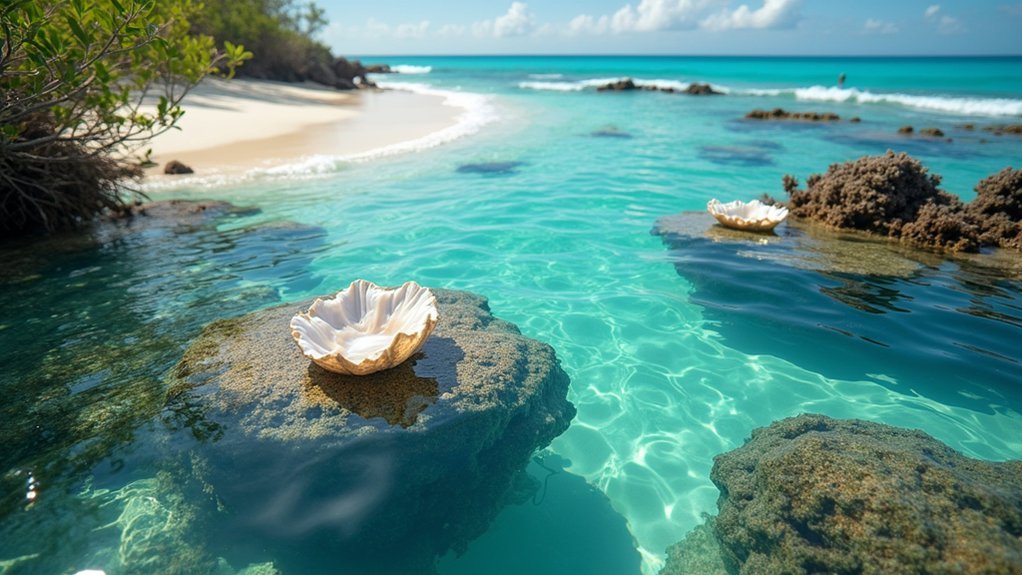
When you choose sustainable pearl cultivation methods, you’re investing in practices that protect marine ecosystems while producing high-quality pearls.
These sustainable practices prioritize oyster health by maintaining clean, pollutant-free environments that guarantee ideal water quality. You’ll find that ethical pearl farms utilize biodegradable materials and natural filtration systems, considerably reducing their ecological footprint while minimizing marine pollution.
Effective waste management programs handle organic waste responsibly, promoting sustainable resource use and preventing water contamination.
Regular water quality monitoring prevents excessive chemical use, maintaining ecosystem health.
Many ethical pearl farms actively engage in habitat restoration projects, replanting mangroves and coral reefs to support biodiversity and restore natural environments affected by farming operations, creating a positive environmental impact.
Environmental Benefits of Responsible Pearl Farming
While sustainable pearl cultivation protects marine environments, responsible pearl farming delivers measurable environmental benefits that extend far beyond the farm boundaries.
You’ll find that cultivated oysters function as natural water filters, removing pollutants and excess nutrients to improve marine ecosystem health.
These farming practices prioritize clean, pollutant-free environments that support local biodiversity balance.
Water Quality Management in Pearl Production
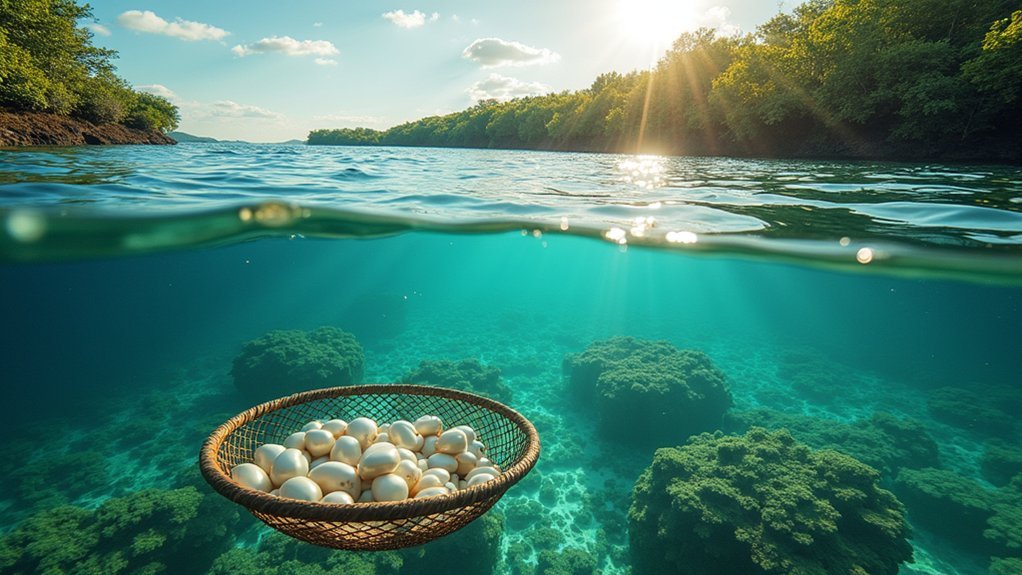
You’ll maintain clean water standards by regularly monitoring temperature, salinity, and nutrient levels to guarantee your oysters thrive in ideal conditions.
You can implement natural filtration systems that use the oysters themselves to filter water, reducing your need for harmful chemicals while maintaining water clarity.
You’ll prevent pollution by establishing strict protocols that keep contaminants away from your farming areas, protecting both your pearl-producing oysters and the surrounding marine ecosystem.
Clean Water Standards
Since water quality directly impacts both oyster health and pearl formation, you’ll need to establish rigorous monitoring systems that track temperature, salinity, pH levels, and nutrient concentrations throughout your farming operation.
Clean water standards aren’t just regulatory requirements—they’re essential for creating thriving marine ecosystems where oysters naturally filter pollutants and enhance surrounding water quality.
Sustainable pearl farms maintain these standards through strategic approaches:
- Implementing natural water filtration systems to reduce chemical dependency
- Using biodegradable materials in all farming operations to prevent contamination
- Following Aquaculture Stewardship Council (ASC) certification guidelines
- Establishing regular testing protocols for key water quality parameters
Natural Filtration Systems
The most effective approach to maintaining these water quality standards harnesses your oysters’ natural filtering abilities as the foundation of your farm’s water management system.
You’ll place oysters in floating baskets or nets that allow unrestricted water circulation, mimicking natural habitats while maximizing filtration efficiency. This method eliminates chemical interventions, positioning your sustainable jewelry brand as genuinely eco-friendly.
Your oysters continuously filter water, removing impurities and enhancing clarity for surrounding marine life.
Regular monitoring guarantees ideal conditions for oyster growth while supporting biodiversity. These eco-friendly practices reduce pollution and preserve marine ecosystems without harmful chemicals or antibiotics.
Pollution Prevention Practices
Beyond natural filtration, extensive pollution prevention requires proactive strategies that protect water systems from contamination at every stage of pearl production.
You’ll need to implement thorough pollution prevention practices that eliminate harmful chemicals and antibiotics from your operations. Effective water quality management involves regular monitoring to maintain ideal conditions while preventing excessive chemical use that leads to contamination.
Your sustainable practices should include:
- Regular water testing to monitor pH levels, oxygen content, and pollutant concentrations
- Complete elimination of harmful antibiotics and synthetic chemicals from farming operations
- Implementation of extensive waste management programs for organic materials and oyster shells
- Use of biodegradable materials and sustainable resources throughout your pearl farming operations
These strategies guarantee you’re maintaining clean, pollutant-free environments that protect surrounding marine ecosystems.
Biodegradable Materials and Waste Reduction Strategies
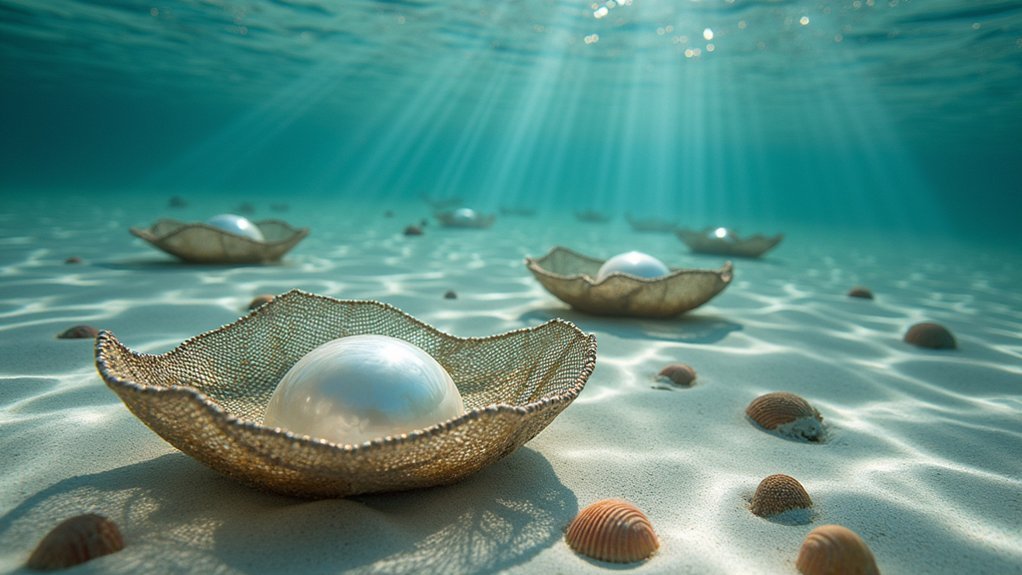
When pearl farmers embrace biodegradable materials and extensive waste reduction strategies, they’re making a powerful commitment to environmental stewardship that extends far beyond their immediate operations.
You’ll find that sustainable pearl farming prioritizes biodegradable septic systems, which greatly reduce environmental impact while promoting long-term sustainability. These waste reduction strategies include recycling and repurposing materials, minimizing waste streams, and ensuring responsible disposal of oyster shells and biological matter.
You can implement natural cleaning methods by utilizing fish to clean oysters instead of harmful high-pressure hoses.
Through innovative waste management programs, you’ll prevent water contamination while enhancing local ecosystems through organic waste recycling. This thorough approach demonstrates how responsible farming practices create positive environmental outcomes.
Solar and Renewable Energy Use in Pearl Farms
As pearl farmers increasingly harness solar and wind power to meet their electricity demands, they’re revolutionizing sustainable aquaculture while dramatically cutting their carbon footprint and fossil fuel dependence.
When you’re sourcing pearls for your sustainable jewelry company, you’ll find that solar energy installations on pearl farms power essential operations like water filtration and oyster maintenance systems.
These eco-friendly farming practices deliver multiple benefits:
- Solar panels reduce operational costs while providing reliable, clean electricity for daily farm operations
- Wind turbines complement solar installations, creating extensive renewable energy systems
- Renewable power minimizes marine pollution, protecting delicate ocean ecosystems where oysters thrive
- Energy independence allows farms to operate sustainably without relying on grid electricity from fossil fuels
This commitment to renewable energy demonstrates how modern pearl farming aligns with environmental conservation principles.
Natural Oyster Care and Habitat Preservation
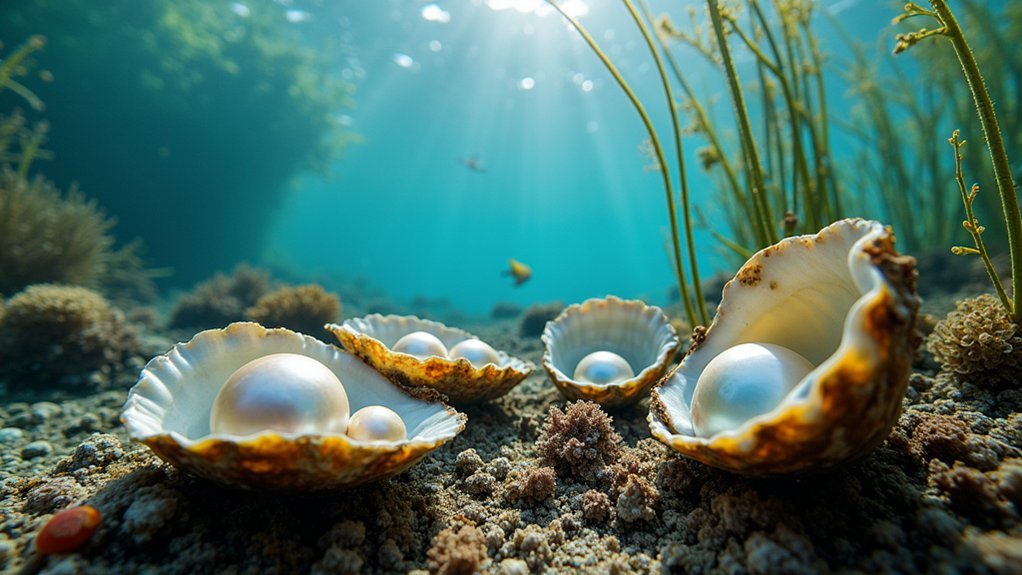
Pearl farmers who invest in renewable energy systems complement their sustainable approach by implementing thorough oyster care practices that protect marine habitats. Natural oyster care involves maintaining pollutant-free environments that support ideal water quality and ecosystem balance. You’ll find sustainable pearl farms cultivating oysters above lagoon floors, ensuring maximum oxygen access while minimizing environmental impact.
| Practice | Traditional Method | Sustainable Alternative |
|---|---|---|
| Oyster Cleaning | High-pressure hoses | Fish for natural cleaning |
| Chemical Use | Harmful pesticides | Eco-friendly alternatives |
| Habitat Impact | Floor cultivation | Elevated positioning |
Habitat preservation extends beyond farming operations. You’re supporting farms committed to restoration projects, including mangrove and coral reef replanting. These techniques foster healthier marine environments while avoiding ecological problems caused by intensive farming practices.
Ecosystem Enhancement Through Pearl Farming
Beyond protecting existing habitats, you’ll discover that pearl farming actively enhances marine ecosystems through natural biological processes. Your oysters function as living water filters, removing pollutants and improving water quality throughout their feeding cycles.
This sustainable approach creates measurable environmental benefits that extend far beyond pearl production.
When you implement responsible farming practices, you’re actively contributing to marine ecosystem health:
- Water filtration: Oysters naturally filter massive volumes of water daily, removing excess nutrients and harmful particles
- Biodiversity support: Controlled cultivation reduces pressure on wild oyster populations, allowing natural habitats to recover
- Habitat restoration: Many pearl farming operations actively replant mangroves and restore coral reefs
- Symbiotic relationships: Eco-friendly techniques create mutually beneficial connections between aquaculture and surrounding marine life
Your commitment to sustainable pearl farming directly translates into measurable ecological improvements.
Social Responsibility and Fair Labor Practices

Everyone benefits when pearl farming operations prioritize fair labor practices and social responsibility.
You’ll find that ethical pearl farms maintain remarkably low employee turnover, with some team members contributing since 1993. These operations pay employees exceptionally well, creating unity and respect that directly enhances work quality.
Unlike traditional farms operating under military-style hierarchies with poor conditions, responsible operations emphasize teamwork and community living. Team members work, eat, and live together, fostering genuine collaboration.
You’ll discover that many sustainable farms donate percentages of sales to environmental organizations and support local artisans.
When you choose pearls from farms prioritizing social responsibility, you’re supporting operations that avoid exploitative practices and guarantee fair labor standards, benefiting entire communities.
Transparency and Certification Standards
When you’re evaluating pearl farming operations, you’ll want to look for third-party verification programs like MSC and ASC certifications that validate sustainable practices.
You can trace your pearls’ journey from farm to market through supply chain traceability systems that document each step of production.
You’ll also find environmental impact reporting from responsible farms that openly share data about their water quality management, waste reduction efforts, and ecosystem effects.
Third-Party Verification Programs
As pearl farming continues to expand globally, third-party verification programs have emerged as essential guardians of environmental and social responsibility within the industry.
Organizations like the Marine Stewardship Council (MSC) and Aquaculture Stewardship Council (ASC) establish rigorous standards that ethical pearl farms must meet to achieve certification. These sustainable practices guarantee you’re supporting operations committed to environmental protection and social accountability.
When you choose certified pearls, you’re driving market demand that encourages more farms to adopt eco-friendly methods.
Third-party verification programs create measurable impact through:
- Regular compliance assessments guaranteeing ongoing adherence to environmental standards
- Mandatory transparency in waste management and chemical usage
- Habitat preservation requirements protecting marine ecosystems
- Social responsibility criteria safeguarding worker welfare and community interests
Supply Chain Traceability
Building on these verification standards, supply chain traceability transforms how you can track your pearls’ entire journey from cultivation to purchase. This transparency guarantees you’re supporting ethical pearl farms that maintain sustainable practices throughout their operations.
When you choose certified pearls, you’ll receive detailed documentation showing cultivation methods, environmental impact measures, and labor practices.
Certifications from organizations like MSC and ASC provide the verification you need to make informed decisions. These standards require farms to maintain thorough records, creating accountability at every step.
You’ll find that ethical pearl farms willingly share their practices, demonstrating their commitment to responsible sourcing. This traceability reduces risks associated with harmful farming methods while supporting the growing demand for eco-friendly jewelry options in today’s conscious marketplace.
Environmental Impact Reporting
Since transparency builds consumer trust, environmental impact reporting becomes your primary tool for evaluating a pearl farm’s true commitment to sustainability.
Ethical pearl farms must demonstrate their environmental stewardship through thorough assessments that detail their effects on marine ecosystems. This transparency helps you make informed decisions when sourcing sustainable jewelry.
Certification standards from organizations like the Marine Stewardship Council (MSC) and Aquaculture Stewardship Council (ASC) provide essential frameworks for accountability. These standards require farms to undergo third-party audits, verifying compliance with environmental management criteria.
Key elements of robust environmental impact reporting include:
- Third-party verification of environmental management practices
- Documentation of resource use efficiency and waste reduction
- Assessment of impacts on local marine biodiversity
- Evidence of continuous improvement and adaptation to new sustainability standards
Community Impact and Conservation Efforts
While pearl farming primarily focuses on cultivating lustrous gems, responsible operations extend their impact far beyond commercial production by actively engaging with local communities and supporting conservation efforts.
You’ll find that successful farms create educational programs promoting sustainable practices and environmental responsibility among stakeholders. These operations contribute to biodiversity through habitat restoration, replanting mangroves and coral reefs essential for marine ecosystems.
Community impact extends through partnerships with local artisans and small businesses, ensuring economic benefits reach broader populations. Many responsible farms donate sales revenue portions to environmental organizations like the NRDC, supporting conservation initiatives.
Identifying Ethical Pearl Suppliers and Brands
When you’re shopping for pearls, distinguishing ethical suppliers from those with questionable practices requires careful research and attention to key indicators.
You’ll want to prioritize transparency about farming methods and verify that sustainable practices protect marine ecosystems. Look for pearl farms certified by reputable organizations that maintain strict environmental standards.
Key indicators of ethical pearl suppliers include:
- Certification credentials – MSC or ASC verification ensuring sustainable and responsible farming practices
- Community engagement – Active involvement in local education initiatives and conservation programs
- Environmental commitment – Participation in programs like One Percent for the Planet demonstrating genuine dedication
- Chemical-free operations – Farms that avoid harmful substances while prioritizing water quality and biodiversity
These ethical pearl farms contribute positively to ocean health while producing beautiful, responsibly-sourced gems.
Frequently Asked Questions
Is There an Ethical Way to Harvest Pearls?
You can harvest pearls ethically by choosing farms with sustainable practices, humane oyster treatment, and environmental certifications. Look for operations that prioritize oyster welfare, use biodegradable materials, and engage local communities responsibly.
Is Pearl Farming Eco-Friendly?
You’ll find pearl farming can be eco-friendly when you choose sustainable practices like avoiding harmful chemicals, maintaining clean water, using biodegradable materials, and supporting habitat restoration projects that enhance marine biodiversity.
Can Pearls Be Harvested Without Killing the Oyster?
You can harvest pearls without killing oysters through nucleation techniques that maintain a 50% survival rate. You’ll find responsible farms use non-lethal methods, allowing oysters to live and produce multiple pearls throughout their lifespan.
Is Pearl Jewelry Sustainable?
You’ll find pearl jewelry can be sustainable when you choose pieces from farms using eco-friendly practices, avoiding harmful chemicals, and maintaining certifications like MSC or ASC standards.
In Summary
You’ll find that choosing ethically-sourced pearls isn’t just about beautiful jewelry—it’s about supporting sustainable practices that protect marine ecosystems and coastal communities. When you’re selecting pearls, you’re investing in responsible farming methods, renewable energy use, and fair labor practices. By partnering with certified ethical suppliers, you’re ensuring your business contributes to ocean conservation while meeting growing consumer demand for environmentally-conscious luxury goods.

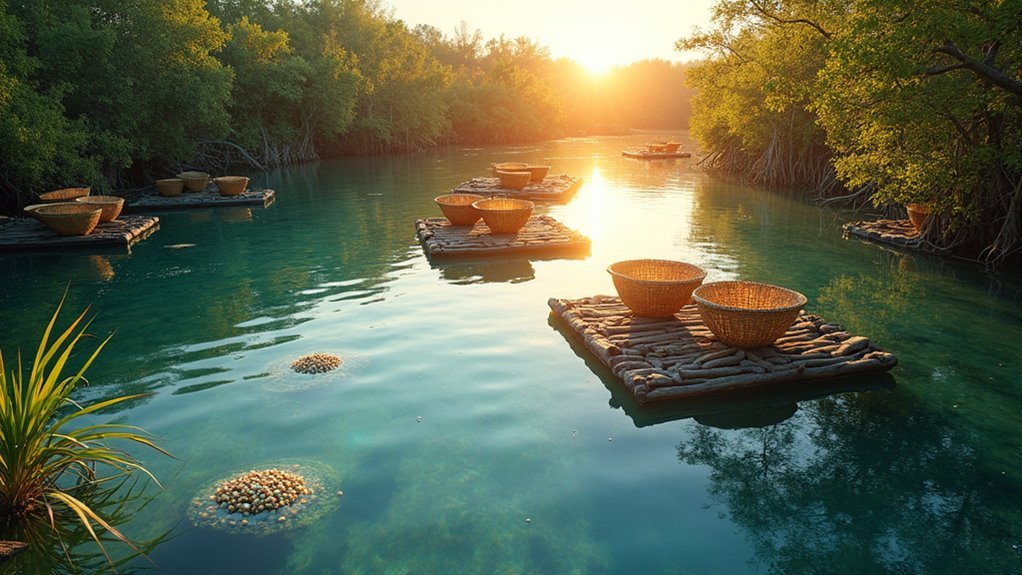
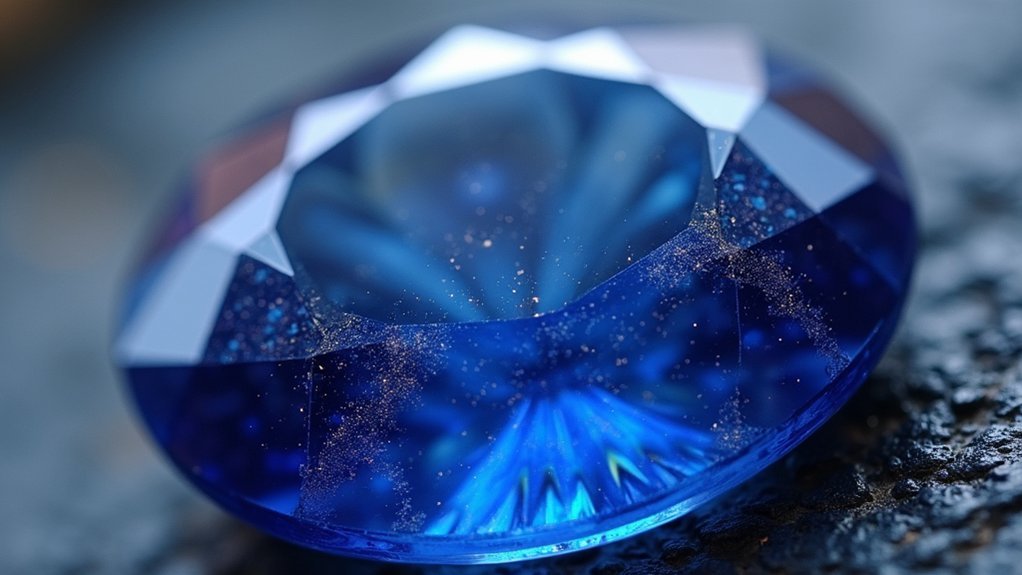

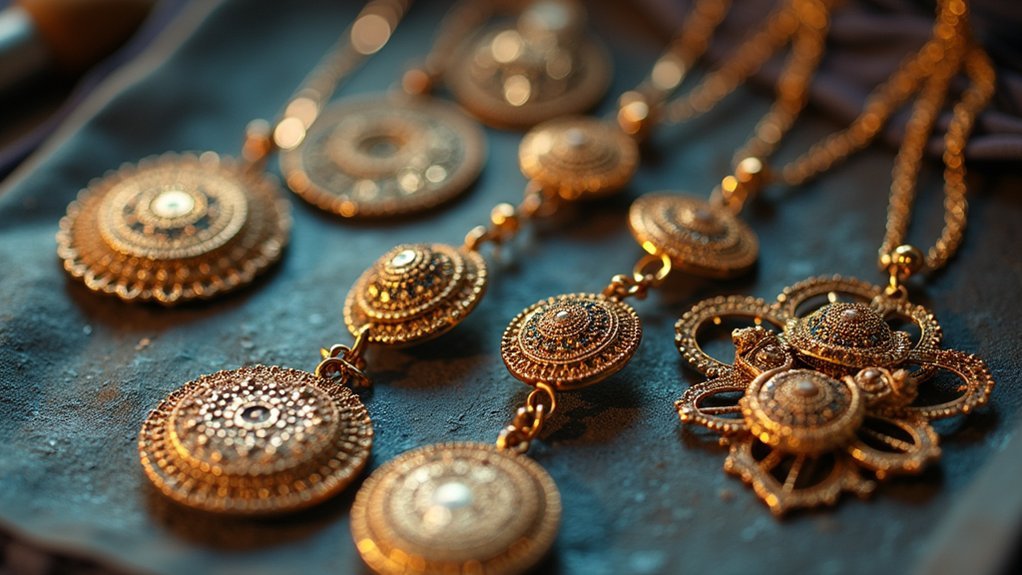
Leave a Reply